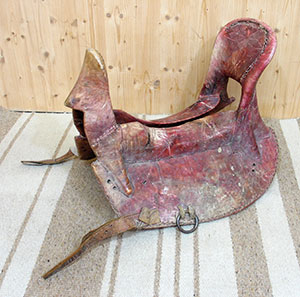
Even in early times, saddle makers recognized the need for properly constructed trees with large weight-bearing surfaces in the middle.
I often get asked about my opinion on the latest and newest saddle designs, such as the saddle tree, appearing on the market. I have to of course be very careful about what I say, lest my comments are taken ‘on the record’ and possibly get back to the manufacturer to be misconstrued as slander or defamation. This is not ever my intent, but with my 35+ years of experience and continuing relentlessness in pursuing constant professional development, I think that my opinions do hold significant merit. So without specifically mentioning any particular brand, model, or saddle design, I think one of the best ways to discuss the pros and cons of the various saddles on the market is to dig deep into the saddle – to the tree, (or lack thereof) which is the basis is for all saddles.
Saddle making history shows us that the saddle trees looked almost the same for 4,300 years. For a very long time the horse was a necessity for mankind, so it was very important to keep the horses healthy and sound for human needs. The horse was an asset and not used so much for sports, nor regarded as a disposable or recyclable commodity.
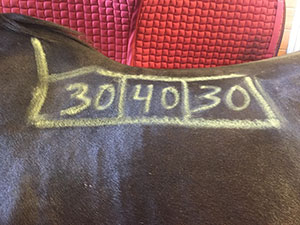
The Saddle Support Area (ideal weight distribution percentages).
Once the horse became more involved in sports, and humans started to even use them for bragging rights, saddle tree design started to change to accommodate all the different sports humans used for the horse for. For riders looking for the next competitive edge, or wanting to use the same saddle as elite riders endorsed, the saddle industry started to design saddles differently for the various disciplines in both English and Western riding. However, all of trees should have a common goal: to bridge the withers, distribute the weight, and balance the rider. Most horses have a 4 inch wide by 16 inch long saddle support area on each side of the spinal column. Imagine you divide this evenly into three parts on each side. The tree is designed so that the front and rear fields each carry 30% and the middle part carries 40% of the saddle and rider’s weights.
The army and the western trees are very big and distribute the rider’s weight over a large surface as the rider sits for long time on the horse’s back. These trees have longer bars in the front and in the back, to allow the load of extra weight or gear for the job that needs to be done. The horse is rarely engaged, or ‘round’ as it would be on a Jumping or Dressage horse. The rider sits in the middle or to the rear of the saddle, on the saddle’s relatively large weight bearing surface. The longer the rider needs to sit in the saddle, the wider the tree needs to be in the middle. This is necessary in order for the horse to be allowed to do a “tree lift”. The tree lift will happen when the horse raises his back in the middle, and the saddle tree lifts from the middle to the front of the shoulders and rear parts of the tree on the horse’s loins.
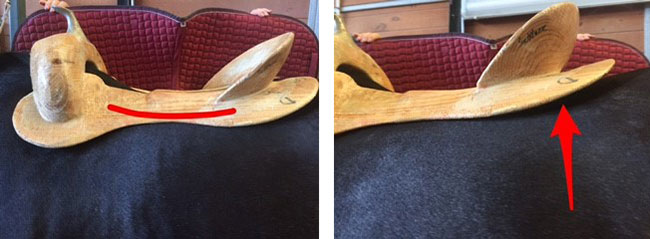
Left: The Army/Western Tree. Right: The flare of the western bars in the back.
The racing tree is completely the opposite of the western tree, and has very little weight bearing surface. The racing saddle tree is very narrow or ends in the middle, as the jockey never really sits on the horse’s back. Unlike any other equestrian discipline the racing industry is designed for speed and endurance, and is one of the few disciplines where the rider does not sit in the saddle to engage the horse’s back but rather stands in the stirrup leathers. The Stirrup leathers are hung on the stirrup bar/gullet plate, on a half or full tree on the exercise or racing saddle tree. The jockey stands for a brief moment in training on the horse’s back, and for an even shorter time during the race.

A modern racing saddle tree.
The English tree is for a sporting saddle used to train the horse by sitting in the saddle (opposite of racing saddle trees) to get the weight off the forehand of the horse, by engaging the horse’s back. This requires quite the skill for the rider – to create enough contact with the seat, while sitting lightly enough for the horse to be able to lift its back. If the horse lifts the back in the middle under the saddle tree, the horse will to be able to pivot his pelvis under, so the hind leg can step underneath closer to the horse’s centre of gravity. This way the horse will carry more weight on the hind leg, and decrease the weight (pressure) on the front legs. Once you inspect the horse’s back a little bit closer, you will see that the top of the horse’s back (where the saddle tree sits) is relatively straight, while the majority of the English trees have a stronger rock (curvature) to the bottom of the tree. The wider the tree in the middle, or the stronger the “rock”, the less pressure will be exerted on the horse’s loin or shoulders. If the tree is narrow in the middle, or straighter on the bottom, there will be excess heat/pressure in the shoulder and loin area.
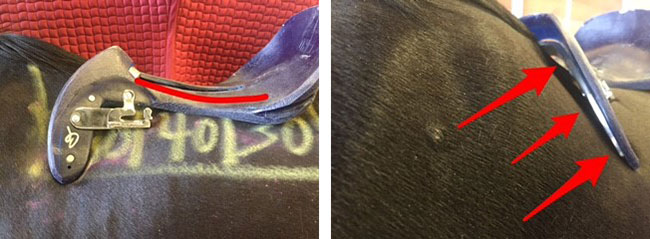
Left: proper English tree design with ‘rock’. Right: Proper freedom in the shoulder area with the correct angle.
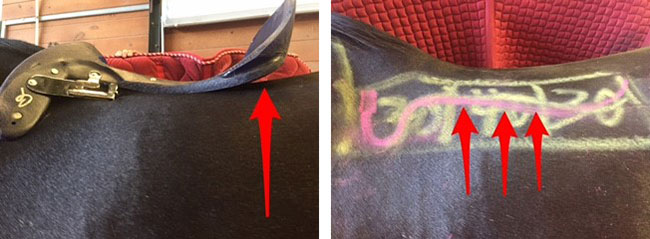
Proper freedom at the loin for the back to engage with enough support in the center to allow ‘tree lift’.
Some saddle companies today have come up with some rather arbitrary tree designs, with misleading advertising and obvious misconceptions about the horse’s biomechanics. Some saddle designers or saddle fitters misunderstand the necessary principle that the saddle tree needs to be wide in the middle while having a slight rock – a design feature which has been followed for over 4300 years. If the horse’s back moves up and down the lower amount of pressure will be on the front and rear portions. Some saddle designs put large surface area in the first 30% of the area, very little in the middle, and a little more in the back – approximately 50/20/30 %.

This tree is too straight and hollow in the middle to ensure necessary ‘tree lift’ during movement.
Some saddles use ‘posts’ to suspend the saddle tree in the front and back areas, while the middle has barely any weight-bearing surface (approx. 40/20/40.) Often we see atrophy and white hair that appears on the horse’s back in the front or in the back, yet rarely in the middle. You only see white hair in the middle of the horse’s back when the horse has been ridden for extended periods of time in a treeless saddle. While we have scientific diagnostic tools such as fiberoptic cameras, heart monitors, thermography, and computerized saddle pads, people who design saddles will sometimes discredit the information these tools provide because of personal opinion and bias. They seem to lack the necessary integrity and may be driven by the almighty dollar in making decisions on what saddles to sell – for the good of their pocketbook rather than for the horse.
I hope that with my many articles, videos, and from the information in my book people will be able to form their own opinions based on doing their own due diligence and research to protect their horses from long term back damage.
~ Jochen Schleese CMS, CSFT, CSE, courtesy of Saddlefit 4 Life
